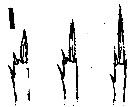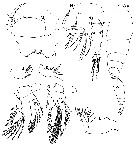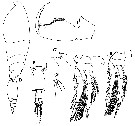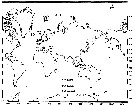|
|
 |
|
Cyclopoida ( Order ) |
|
|
|
Oncaeidae ( Family ) |
|
|
|
Oncaea ( Genus ) |
|
|
| |
Oncaea lacinia Heron, English & Damkaer, 1984 (F,M) | |
| | | | | | | Ref.: | | | Heron & al., 1984 (p.476, figs.F,M); Heron & Bradford-Grieve, 1995 (p.43, figs.F,M); Bradford-Grieve & al., 1999 (p.887, 970, figs.F,M); Heron & Frost, 2000 (p.1050, figs.F, tab.2, 3) |  issued from : G.A. Heron & B.W. Frost in Proc. Biol. Soc. Washington, 2000, 113 (4). [p.1051, Fig.20, F)]. Female (from NE Pacific): F, pediger 4 posterior corner and urosome (dorsal; scale bar: x). Scale bars: 0.1 mm, see figures 3, 4, 5, 10 of Heron and Frost, 2000 for Oncaea canadensis and Oncaea insolita.
|
 issued from : G.A. Heron & B.W. Frost in Proc. Biol. Soc. Washington, 2000, 113 (4). [p.1022, Fig.2, I]. Female: P2-P4 endopod terminal ''spine set'' (combination of the lengths, shapes, and position of the three or two terminal spines on the endopods of swimming legs 2-4 , from left to right in figure, for different Oncaea' species). Nota: endopod of P2 with subterminal spine extending to less than half the length of terminal spine.
|
 issued from : G.A. Heron, T.S. English & D.M. Damkaer in J. Crustacean Biol., 1984, 4 (3). [p.475, Fig.14, F-O]. Female (from Arctic): F, habitus (lateral; scale bar: w); G, posterior of last prosomal segment and urosome (dorsal; scale bar: W); H, right A2 (scale bar: x); I, labrum (ventral; scale bar: x); J, left Md (scale bar: w); K, right Mx1 (scale bar: x); L, left Mx2 (scale bar: x-; M, right Mxp (scale bar: x); N, P1 (scale bar: z); O, P2 (scale bar: z).
|
 issued from : G.A. Heron, T.S. English & D.M. Damkaer in J. Crustacean Biol., 1984, 4 (3). [p.477, Fig.15, A-G]. Female: A, P3 (scale bar: z); B, P4 (scale bar: z); C, P5 (scale bar: x). Male: D, habitus (lateral; scale bar: w); E, posterior of last prosomal segment and urosome (dorsal; scale bar: W); F, left Mxp (scale bar: x); G, P5 (scale bar: x).
| | | | | Compl. Ref.: | | | Razouls & al., 2000 (p.343, tab. 4, Appendix); Nishibe & Ikeda, 2004 (p.931, Tab. 2, 4,); Zakaria & al., 2016 (p.1, Table 1, Rem.) | | | | NZ: | 6 | | |
|
Distribution map of Oncaea lacinia by geographical zones
|
| | | | | | | | |  issued from : G.A. Heron & B.W. Frost in Proc. Biol. Soc. Washington, 2000, 113 (4). [p.1060, Fig.24]. issued from : G.A. Heron & B.W. Frost in Proc. Biol. Soc. Washington, 2000, 113 (4). [p.1060, Fig.24].
Locality records for selected species of Oncaea.
Records include previously published personal observations and data presented in this study (p.1023, Table 3). |
| | | | Loc: | | | Antarcic. (SW Pacif.), Arctic, Norwegian Sea, NE Pacif., Washigton inland, NE Japan (Oyashio region), E Medit. (W Egyptian coast) | | | | N: | 7 | | | | Lg.: | | | (675) F: 0,48-0,42; M: 0,46-0,38; (681) F: 0,42; (848) F: 0,42-0,47; M: 0,36-0,38; {F: 0,42-0,48; M: 0,36-0,46} | | | | Rem.: | bipolar species.
Sampling depth (Antarct.) : 0-125 m.
For Heron & al. (1984, p.478), the species is similar to O. setosa, but may be distinguished by differences in the relative prosome/urosome lengths, the urosome measuring more than one-half the prosome length for O. lacinia and approximately one-half for O. setosa. O. lacinia lacks a cluster of spinules on A2 segment 2 and differs by the relatively long setule representing P6 of the female. P5 of O. setosa is a free segment while that of O. lacinia is not dorsally delimited. The setae lengths of P5 are slightly variable for both species, but relative differences between lengths is less for O. lacinia (1:2), compared to 1:3 for O. setosa. O. lacinia also resembles but may be distinguished from the species which Sars (1918) identified as O. minuta Giesbrecht, 1892 (= Triconia minuta; Sars's species differs from Giesbrecht's original desctription by the P4 endopod lacking a terminal conical projection. | | | Last update : 16/01/2018 | |
|
|
 Any use of this site for a publication will be mentioned with the following reference : Any use of this site for a publication will be mentioned with the following reference :
Razouls C., Desreumaux N., Kouwenberg J. and de Bovée F., 2005-2025. - Biodiversity of Marine Planktonic Copepods (morphology, geographical distribution and biological data). Sorbonne University, CNRS. Available at http://copepodes.obs-banyuls.fr/en [Accessed January 05, 2026] © copyright 2005-2025 Sorbonne University, CNRS
|
|
 |
 |








